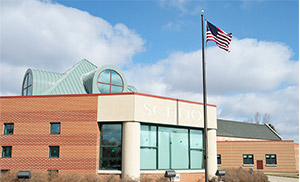Posted on September 23, 2014 by Matheny

Cindy and Hannah LaBar.
Cindy LaBar, Matheny’s director of physical therapy, is also the parent of a child with a disability. Her eight-year-old daughter Hannah was born with a rare chromosome anomaly. LaBar’s experience with Hannah has helped her understand “what families of our students and patients are faced with.”
In an article she wrote for the July/August 2014 issue of NDTA Network, the magazine of the Neuro-Developmental Treatment Association, LaBar outlined several key points for parents of children with disabilities to keep in mind:
• “Find balance between therapy goals and family time.”
• “Maintain open, ongoing communication with your child’s school team and within your family.”
• “Integrate physical and academic functional skills into your daily routines at home.”
• “Place importance on skills and have expectations for your child.”
• “Be creative and create a positive, peaceful environment for your child and family while having fun!”
LaBar acknowledged in the article that, during the first year of Hannah’s life, “I forgot one very important thing: I was her mom first, not her therapist. I struggled tremendously to find a balance. I have often thought how ironic it is that I specialize in helping children just like Hannah learn to move. I have wondered why it is that my work and personal worlds are so similar. I wonder why Hannah was chosen to be with our family. Of course, I cannot fully answer any of these questions, but I do feel confident that Hannah has included me in her journey so I can help other families find this balance that I have been searching for.”
Posted on July 16, 2013 by Matheny

Cindy LaBar and Matheny student Ryan O'Connor.
Cindy LaBar has always wanted to work with children. But she had never spent much time around kids with developmental disabilities until interning at Matheny in 2003 after receiving her MS in physical therapy from Columbia University. “It’s the small accomplishments that are so rewarding and are so huge for our students and patients,” she notes. For example, “one of my students had a really hard time holding up his head. By putting him on the therapy ball on his back, he was able to hold his head up for a brief time, and he broke into a big smile.”
After her internship, LaBar joined the Matheny staff and was named director of physical therapy in 2006. Ironically, her daughter Hanna was born with a rare chromosome anomaly as well as a cleft palate and heart defect. Hanna, who is now seven, is non-verbal and in a wheelchair, although, according to LaBar, “she can take about 20 steps alone.”
Her experience with Hanna has helped LaBar understand what the families of students and patients are faced with. “ You constantly have to be an advocate for your child—the right school, the right therapies. My focus here has shifted a little to really get involved with the families.”
Hanna has also had an impact on LaBar’s own family. “If my five-year-old son Jack sees a kid in a wheelchair,” she says, “he wants to know him.”

Cindy LaBar and her daughter Hanna.
Posted on May 9, 2013 by Matheny

Matheny student utilizes a walker, assisted by a physical therapist.
Related therapy services are vital to the core of the Matheny School program. Occupational, physical and speech therapies are integrated into the school program through authentic tasks and settings.
In physical therapy, students utilize adaptive tricycle riding, standing and alternate positioning programs developed by physical therapists. In speech, students are not limited to speech patterns and topics chosen by the curriculum teams. They enjoy phrases selected by either themselves or their parents. Occupational therapy looks to enhance all areas of functional life with a focus towards real world expectations.
For more information about the Matheny School, call (908) 234-0011, ext. 237.
Posted on April 11, 2012 by Matheny

Alexis Reynolds familiarizes herself with a gait trainer, a walker that supports patients who cannot hold themselves in a standing position. At left is Matheny physical therapist Tara Wach.
We at Matheny are doing our part to ensure that future healthcare professionals understand how to care for and treat people with disabilities. Every year, a group of physical therapy students from UMDNJ visit Matheny to learn about the needs and equipment required by persons with developmental disabilities.
During this year’s visit, the PT students rotated through seven stations dealing with switch access, communication devices, pressure mapping, standing and adaptive tricycles, power and manual wheelchairs, gait trainers and recreational activities.

UMDNJ PT student Melissa Mendez tries out a wheelchair that converts to a stander.
Posted on October 18, 2011 by Matheny
 It’s not a big deal, right—opening a hand? For a boy named Sean it is. Diagnosed with athetoid cerebral palsy at 18 months, he’s “tactile defensive”—super-sensitive to touch. But now, at Matheny, he’s been able to open his hands for the first time—a major goal of his physical therapy.
It’s not a big deal, right—opening a hand? For a boy named Sean it is. Diagnosed with athetoid cerebral palsy at 18 months, he’s “tactile defensive”—super-sensitive to touch. But now, at Matheny, he’s been able to open his hands for the first time—a major goal of his physical therapy.
Sean’s mom, Kelly, thinks the staff deserves a hand—for going “above and beyond. Sean is safe here,” she says, “because he’s surrounded by people who love him.”
Sean, shown here working with physical therapist Erin Guidera, is just one of nine “Special Stories” we highlight in a new publication: www.matheny.org/Matheny-Brochure.pdf.
Posted on October 14, 2011 by Matheny
Two years ago , William Miller of Succasunna had trunk control so weak he was “falling all over the place,” says his physical therapist, Diane Tavares, MS, PT. Now the five-year-old can play catch, throw at a target and walk the balance beam all by himself. What helped make the difference was the physical-therapy support he received, not only from Tavares, but also from his teacher, Patti Klein, and the teacher’s aides in William’s public school, Jefferson Elementary.
, William Miller of Succasunna had trunk control so weak he was “falling all over the place,” says his physical therapist, Diane Tavares, MS, PT. Now the five-year-old can play catch, throw at a target and walk the balance beam all by himself. What helped make the difference was the physical-therapy support he received, not only from Tavares, but also from his teacher, Patti Klein, and the teacher’s aides in William’s public school, Jefferson Elementary.
Twice-weekly 30-minute sessions “weren’t going to fix someone like William,” says Tavares. “It had to be continuous all day.” So, under Matheny’s Therapy Solutions program, she taught Klein and the aides some of the physical therapy techniques she was using in her sessions with William. And as a result of this “teaching the teacher” approach, today the boy’s mom reports he’s doing “wonderfully.”
Above, Tavares works with William on a balance beam. To learn more, visit www.Matheny.org/Solutions, e-mail Solutions@Matheny.org or call 908.234.0011, ext. 751.A
Posted on October 12, 2011 by Matheny
Physica l therapy is different at Matheny than in a sports medicine clinic or a nursing home. And Erin Leach should know—she’s worked in all three settings.
l therapy is different at Matheny than in a sports medicine clinic or a nursing home. And Erin Leach should know—she’s worked in all three settings.
“In a nursing home, you can improve someone’s function pretty significantly, but at Matheny, with the kids, there is just so much more energy,” Leach says. “I started to realize that what I do can really help them forever.”
Leach, who was voted the 2011 Related Service Provider of the Year by her peers at The Matheny School, also knows it can require creativity to incorporate PT into classroom settings. One example involved a lesson about where different articles of clothing belong on the human body. “The teacher had a big cutout of a person, and the students were working on where the shirt goes, where the shoes go, things like that,” she says. “They had Velcro clothing and shoes. So, when it was my student’s turn, I helped her walk up to the big cutout and put the shoes on. It was the perfect activity.”
Leach, shown here helping 8-year-old student Niara Holmes, understands that “I’m helping them do something they might not otherwise get the opportunity to do—like sitting up or standing up by themselves. I can look back and say, ‘Wow, they’re doing this much better’—even if it may seem to be a very small thing.”
We invite you to share your experience with our physical therapy services on this page.












